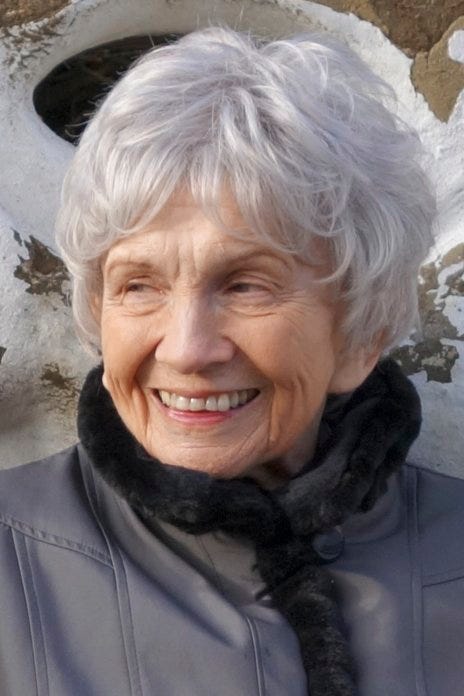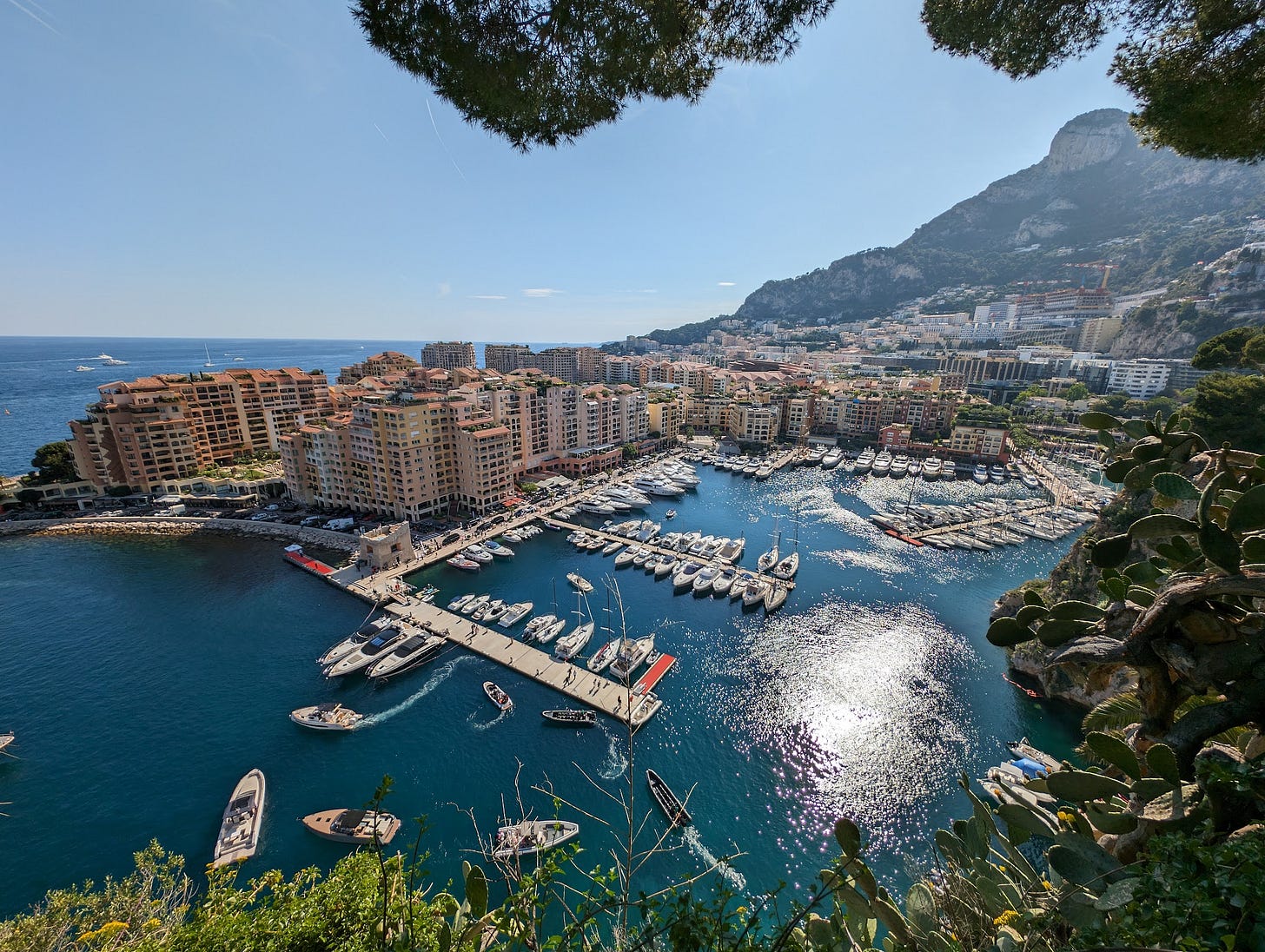Cannes Film Festival 🇫🇷🎥🏖️, Remembering Alice Munro, and the F1 Monaco Grand Prix 🏁🏎️
And Microsoft tries to win over entertainment folks with an AI 🤖 pavilion on the beach
Greetings from France, where most of the Writing Atlas team were gathered for the Cannes Film Festival (or Festival de Cannes, as it’s known in French). While Francis Ford Coppola’s Megalopolis attracted the bulk of the advanced buzz for its epic three-decade journey to the Croisette, here are our festival favorites to watch out over the next year that we wanted to share with the Writing Atlas community.
• Emilia Pérez, written and directed by Jacques Audiard, is a fabulous Mexican drug cartel trans musical comedy film. It stars Argentinian Karla Sofía Gascón in the title role, with Selena Gomez and Zoe Saldaña flexing their musical talents.
• The Substance, written and directed by Coralie Fargeat of France, is a body horror film starring Demi Moore as a parody of herself with nods to Dorian Gray, The Fly, Carrie, and Jekyll and Hyde, and so much more. One of Writing Atlas’s reporter friends said the last 10 minutes was some of the greatest film making she has ever seen. Margaret Qualley plays the DNA equivalent to Demi’s character and Dennis Quaid is the slimy network executive.
• Anora, written and directed by Sean Baker, is a sex-filled Cinderella-esque tale about a Brooklyn exotic dancer who marries the spoiled son of a Russian oligarch in Las Vegas one weekend. Less polarizing than the two above, it has emerged as the highest rated among critics thus far. The film has earned awards buzz for Mikey Madison and is expected to launch the English-language career of Mark Eidelstein, who has been described as a “Russian Timothee Chalamet.” It won the Palme d’Or, the most prestigious award of the festival.
• My Sunshine, written and directed by Hiroshi Okuyama, is a heart-warming/breaking story that follows a young boy named Takuya as he discovers a new passion for figure skating, mentored by the coach and former champion Arakawa and his model student, Sakura. Selected for the Un Certain Regard section (sort of the junior varsity of Cannes vs. the “in competition’ films), My Sunshine quiet and beautiful film, well-received overall, and one of our favorites.
• The Balconettes (Les Femmes au Balcon) , Noémie Merlant (actress, writer, director) and Céline Sciamma (writer) join forces once again to give us another female empowerment film, though one that is drastically different approach from the tragic Portrait of a Lady on Fire. This raunchy, horror comedy follows the friendship of three women during a heatwave in Marseille, getting caught in a (very) bloody mess after visiting a neighbor they had been flirting with from their balcony.
You can also read The New Yorker’s ranking of all 22 competition films.
At Writing Atlas, we mourn the recent death of Alice Munro who is one of our role models as a pioneer of the short story. With Writing Atlas, we hope to spread the wonder of the short story form as an explosive and exhilarating format for fiction. Today, we wish to share some of our favorites from Munro. Our curation comes from Writing Atlas member Bea Phi. As you may remember, they are currently finishing up as student at Stanford University studying Comparative Literature and Creative Writing, a school where, from start to finish, they have read Alice Munro’s stories over and over again. Here are some of their favorites.
“Everyone Wants Me to Read Alice Munro” by Bea Phi
When I found out that Alice Munro had passed, I almost dropped to my knees. It sounds dramatic to say. I had never met her. She never knew I existed. There will never be a tangible or concrete relationship that one can draw between us in this world. Even then, I felt a sense of grief and disorientation in hearing about her loss. I have spent the last few months reading the stories in her very last collection, Dear Life. I have flipped through it in BART and Caltrain subway cars, in coffee shops and restaurants in the nearby University of California at Berkeley campus, and whenever in search of procrastination from assignments and job work. When I went online, to Twitter, on May 13, I found that many people—my own professors, writers I know, and friends here and there—felt the same way. Some shared their favorite stories of hers, while others stated very firmly that she was their reason for writing to begin with. There was overall a sense of great bereavement online from those who had and hadn’t known her personally. Everyone had read her work and taken it very seriously.
I feel similarly about her passing. When I took my first workshop in college, I had only just started writing fiction in my own time and had no sense of who the greats were with regard to the short story. In class, we read George Saunders, Justin Torres, Jamil Jan Kochai, and more: Writers who had an incredible grasp on how to make ten-or-so pages work for a story. At the end of that quarter, my professor told me to read Alice Munro. I had never heard of her. For the next three years and counting, I would read Alice Munro closely in my own time—but also get told, time and time again, to read her in the workshops that followed. I’ve taken ten workshops as an undergraduate at Stanford University now, most of them having to do with the short story. As far as classes go, wherever the short story is concerned, Alice Munro appears. Every professor assigns her work knowing that Alice Munro is truly a master of the form.
One professor of mine once said something along the lines of, “I knew a guy once who said that he didn’t get Alice Munro, or maybe he just didn’t like her very much. That guy is no longer a writer.” Another professor of mine said that Alice Munro is the English language’s Anton Chekhov. To me, she would become more than just an assigned reading or an author whom my professors casually recommended. She would remain an important keystone for me and the style which I was hoping to achieve in prose. I would talk about her whenever others asked me whom I looked to as my north stars in writing. I would seek to bring to my own communities whatever it was which she brought to those in Canada’s countrysides. In celebration of Alice Munro’s life and career as among the most important writers of our time, I want to share some of the pieces of hers which I love the most.
I was recently assigned to read “Wenlock Edge,” (full text here) and I found it completely harrowing. In a very literal but also metaphorical and symbolically rich manner, the story unpacks and unravels the meaning of nakedness, how one feels in one’s own skin, and what it means to be looked at or at the least seen—in any sense of the word—very vulnerably. The subtle yet unnerving scene in which our unnamed narrator is merely sitting there at Mr. Purvis’ dinner table, naked and reading to him, will always stay with me, along with the feelings that I felt reading it once and then a second time. As always, the story has Alice Munro’s hallmark qualities like layered storytelling and switchback time. However, I think the story is also a rather rare moment in her bibliography where she addresses the matters of both city life and college life.
In my inbox is an optional reading from another professor, “Chance” (full text here) which I had always been meaning to read but struggled to find the time to. I was already knee-deep in Dear Life and wanting to push further in that later collection of hers. Only when she passed did I find myself finishing everything of hers which I had in my possession, Dear Life and more. In “Chance,” as the title suggests, we get a chance encounter made unlikely by the passage of time and the ways in which people naturally drift apart from one another as life goes on. Like many other Alice Munro stories, we get to observe our protagonists Juliet and Eric across time and space: train cars, bays, and schools, and the years that pass in between these locales. Here, the prose is expectedly beautiful and full of rich, worldly detail. The story itself is complicated and raises many questions about adultery and passion, but I’m more so drawn to its theme of reminiscence even if illicitly rendered by cheating. It’s these kinds of stories of hers which always inspire within me nostalgia, melancholy, and mourning—but for what?
For my advanced fiction workshop, one of my first readings was “Dimension” (full text here). I believe “Dimension” is one of her most popular stories, and I saw many people tweeting about it after she had passed. In class, we talked about how the story itself evades and disobeys so many conventions about storytelling. The top level of the story begins in an unanticipated place and a rather banal one at that: a series of bus transfers which the narrative itself even acknowledges as trite. The letters from the criminally insane husband are incredibly long and look like an eyesore no matter how they’re paginated. There’s one line at the very end which briefly switches to present tense before the story resumes its past tense: “She pinches the nostrils, takes a deep breath, seals his mouth with her lips, and breathes.” However, even for all of its breaking of convention, it amounts to an incredible short story not in spite of these things but perhaps for the accumulation of them. From start to finish, “Dimension” is an excellent study for writers in craft and creative risk. For readers, it is a thrilling and harrowing picture of a suffocating relationship not for the faint of heart, literally and metaphorically. Some of the quietest moments I’ve ever had in reading fiction—in which all air felt sucked out of the room, and I could hear my own heart beat—occurred while reading that scene, over and over again, in which Doree returns to her house and discovers what happened to her children.
Last but not least, in my journey through Dear Life, done on my own and without assignment, I read “Amundsen” (full text here). It’s another one of those Alice Munro stories which takes place in a school and concerns the people in them. Upon first read, it’s hard to really determine what “Amundsen” is really about other than where it is and whom it involves. Part of reading Alice Munro is acknowledging that while there oftentimes is a story, the story also might no more exist than the world does. It might really just be about people talking with one another and butting heads as human beings do and navigating the circuitous emotions which come with life: love, loss, regret, happiness, sadness, nostalgia … To me, this is Alice Munro at her most quotidian and everyday. Reading it, I feel most convinced by those who say that the crowning achievement of her short stories is achieving the kind of depth or volume which only a novel’s length can arrive at. I also just happen to have a soft spot for stories that take place in schools or institutions. There’s something awfully liminal and confining about them.
Still today, three years after having started my journey through Alice Munro’s work, I have nowhere near exhausted all of it. As one professor often told me, sometimes good reading is only rereading. I believe she got that from Vladimir Nabokov. In that case, I might spend my whole life reading and rereading all of Alice Munro’s short stories in order to learn more about how she does it. How does she craft a character so full and rich with life in only ten-or-so pages? What is it about her worlds which attain the detailed mass of a novel? Where are all of these emotions coming from, and why do they so powerfully and convincingly reach me?
As an aspiring writer of short stories, I know I owe so much gratitude to Alice Munro even though I’ve yet to even scratch the surface of her wonder and genius. Hers is a kind of inspiration which you can feel not just from her work but also the work of those who have read her—and it seems like just about everyone, and I mean everyone, has read her. The modern short story is one in which she has shaped, or, at the very least, defined some incredible expectation for. We will always and ever be chasing her example.
Bea Phi (they/them) is currently a senior at Stanford University, class of ’24, studying Comparative Literature and Creative Writing. They serve as a Student Worker in the Creative Writing Program and a Peer Advisor in the Department of Comparative Literature. On occasion, they work on plays in the Asian American Theater Project on campus. They also work as an Associate Editor of Online Resources for Poets & Writers and have previously worked as an intern for the Asian American Writers’ Workshop. Time and time again, they join the Writing Atlas team on its brief adventures.
AI Is Not Creative. You Are. Or So Says Microsoft at Cannes
One of the stranger things Writing Atlas saw at Cannes this year was that Microsoft AI had arrived on the Croisette in a major way as an official Cannes partner with as part of a campaign to tout its AI tools to filmmakers. With a build out of a beautiful beachfront café replete with free-flowing alcohol and delicate canapés, Microsoft attempted to charm with a colorful “we come in peace” vibe. In an attempt to inoculate the deep concerns around AI that threw a wrench into the Hollywood union contract negotiations last year, the café’s walls and electric screens carried exhortations like “AI is not creative. You are.” And “AI can’t schmooze. You can.”
One wall read in full:
AI can’t dream at night, wish upon a start or dance like nobody’s watching. It can’t eat too much popcorn, drink too much soda, or jump out of its seat in shock and horror. It can’t learn how to swim, hold a pencil, ride a bike, peel an orange, make a friend, lose a lover, have a crisis of conscience or a moment of turth.
But you can.
The stories you bring to life are unique to the experiences you’ve had as a human being. AI is just a new tool for telling them.
Okay.
There were “Art of the Prompt” sessions each day on how to use Microsoft’s Copilot (not to be confused by Github Co-Pilot, which is also owned by Microsoft), where the large language models were coaxed into helping to write a deck, or a pitch. (In Writing Atlas’s opinion, prompts are like incantations).
Visitors could imbibe free-flowing kookabara detox juice, rosé by the glass, and espressos to order. Upon leaving, they handed you a Microsoft-branded AI water bottle so you would remember that you are creative, but AI is not.
Formula 1 Monaco Grand Prix 🏁🏎️
The day after Cannes ended was the Formula 1 Monaco Grand Prix, less than an hour train ride away from Cannes. A few of our Writing Atlas team members took a quick day trip to experience the vroom sounds and air of excitement (we didn’t have tickets unfortunately). The city was pretty locked down for the race, with any area where you might be able to get a view of the race blocked off with fences and police or high temporary walls.
Luckily, Monaco itself is beautiful — especially scenic seaside garden in the old town area, where we stumbled upon a bar with a sliver of a view of the race.
Then, towards the end of the race, we discovered that one of the roads which had been roped off earlier in the day was now open. Despite major crowds, we managed to catch the end of the race and Charles Leclerc’s highly anticipated win. Being the first Monegasque winner since 1931, winning this race in his native country was a lifelong dream for Leclerc and his late father.
That wraps up our wrap-up for the Cannes Film Festival, as well as our reflections on the late, great Alice Munro. At Writing Atlas, we’re always looking for new stories and cool moments to highlight! If you ever would like to curate stories, or share quirky photos, foods, cool places to visit or roaming stuffed animals with the community, please let us know by leaving a comment or otherwise reaching out to us! As always, keep visiting our Writing Atlas homepage as we keep rolling out exciting changes and updates!
Sincerely,
Your Writing Atlas team












